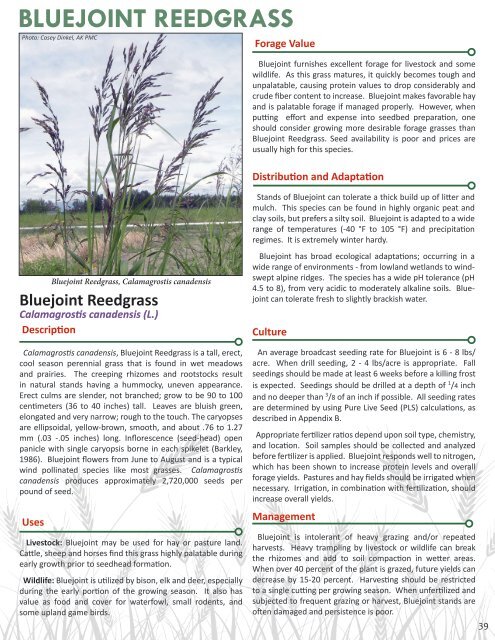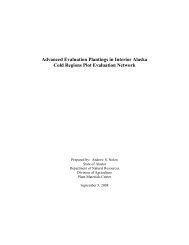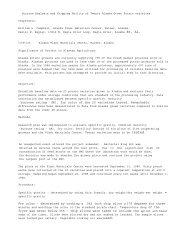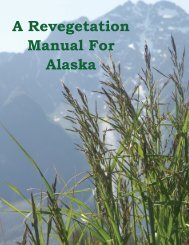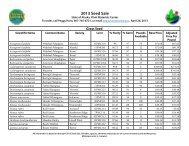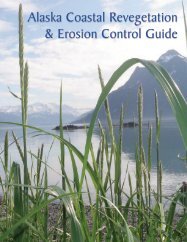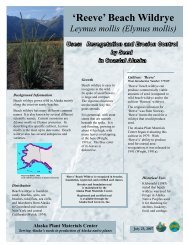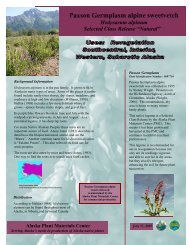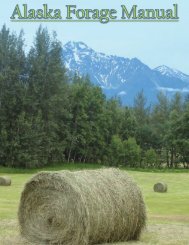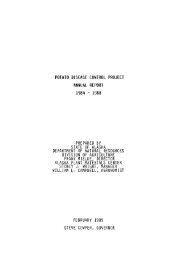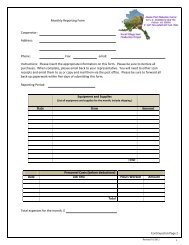Alaska Forage Manual - Alaska Plant Materials Center - State of ...
Alaska Forage Manual - Alaska Plant Materials Center - State of ...
Alaska Forage Manual - Alaska Plant Materials Center - State of ...
Create successful ePaper yourself
Turn your PDF publications into a flip-book with our unique Google optimized e-Paper software.
BLUEJOINT REEDGRASS<br />
Photo: Casey Dinkel, AK PMC<br />
<strong>Forage</strong> Value<br />
Bluejoint furnishes excellent forage for livestock and some<br />
wildlife. As this grass matures, it quickly becomes tough and<br />
unpalatable, causing protein values to drop considerably and<br />
crude fiber content to increase. Bluejoint makes favorable hay<br />
and is palatable forage if managed properly. However, when<br />
putting effort and expense into seedbed preparation, one<br />
should consider growing more desirable forage grasses than<br />
Bluejoint Reedgrass. Seed availability is poor and prices are<br />
usually high for this species.<br />
Distribution and Adaptation<br />
Stands <strong>of</strong> Bluejoint can tolerate a thick build up <strong>of</strong> litter and<br />
mulch. This species can be found in highly organic peat and<br />
clay soils, but prefers a silty soil. Bluejoint is adapted to a wide<br />
range <strong>of</strong> temperatures (-40 °F to 105 °F) and precipitation<br />
regimes. It is extremely winter hardy.<br />
Bluejoint Reedgrass, Calamagrostis canadensis<br />
Bluejoint Reedgrass<br />
Calamagrostis canadensis (L.)<br />
Description<br />
Calamagrostis canadensis, Bluejoint Reedgrass is a tall, erect,<br />
cool season perennial grass that is found in wet meadows<br />
and prairies. The creeping rhizomes and rootstocks result<br />
in natural stands having a hummocky, uneven appearance.<br />
Erect culms are slender, not branched; grow to be 90 to 100<br />
centimeters (36 to 40 inches) tall. Leaves are bluish green,<br />
elongated and very narrow; rough to the touch. The caryopses<br />
are ellipsoidal, yellow-brown, smooth, and about .76 to 1.27<br />
mm (.03 -.05 inches) long. Inflorescence (seed-head) open<br />
panicle with single caryopsis borne in each spikelet (Barkley,<br />
1986). Bluejoint flowers from June to August and is a typical<br />
wind pollinated species like most grasses. Calamagrostis<br />
canadensis produces approximately 2,720,000 seeds per<br />
pound <strong>of</strong> seed.<br />
Uses<br />
Livestock: Bluejoint may be used for hay or pasture land.<br />
Cattle, sheep and horses find this grass highly palatable during<br />
early growth prior to seedhead formation.<br />
Wildlife: Bluejoint is utilized by bison, elk and deer, especially<br />
during the early portion <strong>of</strong> the growing season. It also has<br />
value as food and cover for waterfowl, small rodents, and<br />
some upland game birds.<br />
Bluejoint has broad ecological adaptations; occurring in a<br />
wide range <strong>of</strong> environments - from lowland wetlands to windswept<br />
alpine ridges. The species has a wide pH tolerance (pH<br />
4.5 to 8), from very acidic to moderately alkaline soils. Bluejoint<br />
can tolerate fresh to slightly brackish water.<br />
Culture<br />
An average broadcast seeding rate for Bluejoint is 6 - 8 lbs/<br />
acre. When drill seeding, 2 - 4 lbs/acre is appropriate. Fall<br />
seedings should be made at least 6 weeks before a killing frost<br />
is expected. Seedings should be drilled at a depth <strong>of</strong> 1 /4 inch<br />
and no deeper than 3 /8 <strong>of</strong> an inch if possible. All seeding rates<br />
are determined by using Pure Live Seed (PLS) calculations, as<br />
described in Appendix B.<br />
Appropriate fertilizer ratios depend upon soil type, chemistry,<br />
and location. Soil samples should be collected and analyzed<br />
before fertilizer is applied. Bluejoint responds well to nitrogen,<br />
which has been shown to increase protein levels and overall<br />
forage yields. Pastures and hay fields should be irrigated when<br />
necessary. Irrigation, in combination with fertilization, should<br />
increase overall yields.<br />
Management<br />
Bluejoint is intolerant <strong>of</strong> heavy grazing and/or repeated<br />
harvests. Heavy trampling by livestock or wildlife can break<br />
the rhizomes and add to soil compaction in wetter areas.<br />
When over 40 percent <strong>of</strong> the plant is grazed, future yields can<br />
decrease by 15-20 percent. Harvesting should be restricted<br />
to a single cutting per growing season. When unfertilized and<br />
subjected to frequent grazing or harvest, Bluejoint stands are<br />
<strong>of</strong>ten damaged and persistence is poor.<br />
39


